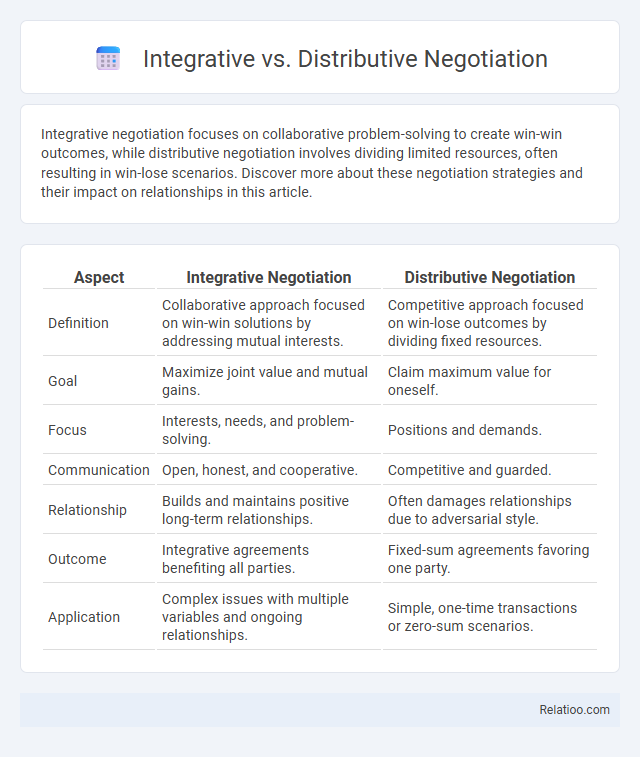Integrative negotiation focuses on collaborative problem-solving to create win-win outcomes, while distributive negotiation involves dividing limited resources, often resulting in win-lose scenarios. Discover more about these negotiation strategies and their impact on relationships in this article.
Table of Comparison
| Aspect | Integrative Negotiation | Distributive Negotiation |
|---|---|---|
| Definition | Collaborative approach focused on win-win solutions by addressing mutual interests. | Competitive approach focused on win-lose outcomes by dividing fixed resources. |
| Goal | Maximize joint value and mutual gains. | Claim maximum value for oneself. |
| Focus | Interests, needs, and problem-solving. | Positions and demands. |
| Communication | Open, honest, and cooperative. | Competitive and guarded. |
| Relationship | Builds and maintains positive long-term relationships. | Often damages relationships due to adversarial style. |
| Outcome | Integrative agreements benefiting all parties. | Fixed-sum agreements favoring one party. |
| Application | Complex issues with multiple variables and ongoing relationships. | Simple, one-time transactions or zero-sum scenarios. |
Understanding Integrative and Distributive Negotiation
Integrative negotiation emphasizes collaborative problem-solving to achieve mutually beneficial outcomes, often involving shared interests and value creation between parties. Distributive negotiation centers on dividing fixed resources, where one party's gain typically results in the other's loss, commonly seen in competitive bargaining scenarios. Understanding these negotiation types helps tailor strategies for either maximizing joint gains or securing the best individual advantage depending on the context.
Core Principles of Integrative Negotiation
Integrative negotiation centers on creating value through collaboration by identifying shared interests and expanding options for mutual gain. Your approach emphasizes open communication, trust-building, and understanding the underlying needs of all parties to craft agreements beneficial for everyone involved. This contrasts with distributive negotiation, which focuses on dividing fixed resources, and cooperation, which involves working together without necessarily optimizing outcomes for all stakeholders.
Key Features of Distributive Negotiation
Distributive negotiation involves dividing a fixed amount of resources, focusing on maximizing individual gain often through competitive tactics such as hard bargaining and limited information sharing. Key features include a single-issue focus, zero-sum outcomes where one party's gain is the other's loss, and short-term relationship considerations. This contrasts with integrative negotiation, which seeks win-win solutions by expanding value, and cooperative negotiation that emphasizes collaboration and mutual benefit.
Major Differences Between Integrative and Distributive Approaches
Integrative negotiation emphasizes collaborative problem-solving to achieve mutually beneficial outcomes, focusing on expanding value and satisfying the interests of all parties involved. Distributive negotiation, also known as positional bargaining, treats resources as fixed and aims at dividing a limited pie, often resulting in a win-lose scenario. Cooperation under integrative negotiation builds long-term relationships and trust, whereas distributive approaches tend to prioritize short-term gains and competitive dynamics.
When to Use Integrative Negotiation Strategies
Integrative negotiation strategies are most effective when parties aim to create value and achieve mutually beneficial outcomes, typically in long-term relationships or complex deals involving multiple interests. This approach leverages collaboration, information sharing, and creativity to expand the negotiation pie rather than merely dividing it. Use integrative negotiation when trust exists between parties and the goal is to maximize joint gains rather than competing for fixed resources.
Situations Suiting Distributive Negotiation Tactics
Distributive negotiation tactics are best suited for situations involving a fixed amount of resources where parties compete to maximize their own share, such as price bargaining or one-time sales transactions. You encounter these tactics in scenarios with limited scope for collaboration or ongoing relationships, where each concession directly impacts your gain or loss. Recognizing when to apply distributive strategies helps preserve your interests when cooperation or integrative negotiation is unlikely to yield mutual benefits.
Advantages of Integrative Negotiation
Integrative negotiation offers you the advantage of creating win-win solutions by focusing on mutual interests and expanding the value available for all parties. This approach fosters long-term relationships and trust, which can lead to more sustainable and collaborative agreements. Unlike distributive negotiation's competitive nature, integrative negotiation promotes cooperation and creativity, resulting in higher satisfaction and better outcomes for everyone involved.
Limitations of Distributive Bargaining
Distributive bargaining focuses on dividing a fixed set of resources, often leading to competitive and adversarial interactions that limit creative problem-solving. You may face challenges such as lack of trust, communication breakdowns, and a win-lose mentality that reduces the potential for long-term collaboration. In contrast, integrative negotiation and cooperative strategies prioritize mutual gains by exploring shared interests and expanding value beyond simple resource division.
Real-World Examples of Both Negotiation Styles
Integrative negotiation emphasizes collaboration to achieve mutually beneficial outcomes, as seen in successful business partnerships where companies share resources to innovate. Distributive negotiation involves competitive tactics to divide limited resources, such as bargaining over salary increases or car prices. Understanding these styles helps you navigate real-world scenarios by choosing cooperation for joint gains or distributive approaches when interests conflict sharply.
Choosing the Right Negotiation Approach for Success
Choosing the right negotiation approach is crucial for achieving success, as integrative negotiation focuses on collaboration to create win-win outcomes through expanding value, while distributive negotiation centers on dividing limited resources and often results in win-lose scenarios. Cooperation encourages open communication and trust-building, enhancing long-term relationships and facilitating integrative strategies. Your ability to assess the context, goals, and relational dynamics will determine whether a cooperative integrative approach or a competitive distributive method is best suited for your negotiation success.

Infographic: Integrative vs Distributive Negotiation
 relatioo.com
relatioo.com